

From Spencer Hutchings:
Read this procedure completely before you buy any parts or attempt the procedure. This procedure covers only '93 RX7's. Not having performed the procedure on any other RX7's there will most likely be different steps but the basics should be the same. Reasonable mechanical skills and access to good tools are required for this repair. If you are not sure you can do this after reading over the procedure, get someone to do it for you. .......Proceed at your own risk.
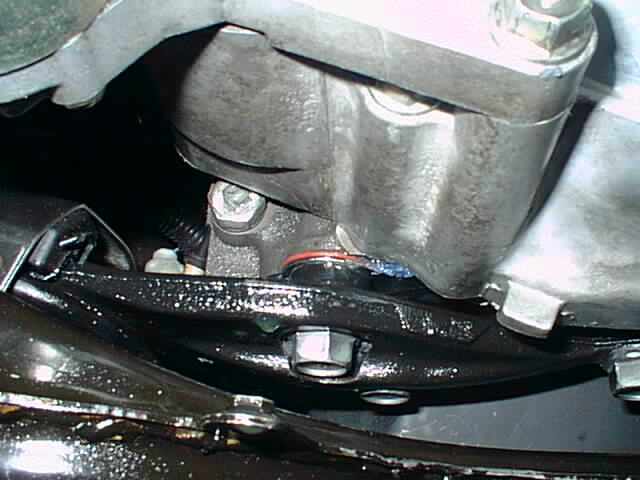
This seems to be the most popular place for the pan to leak, LHS motor mount. I'm not sure why, but the motor mount bolts seem to work loose over time. I suspect that this is due to improper installation by your typical Mazduh mechanic. I tried to remove, clean, and re-torque the mount bolts to no avail. The leak just got worse. See the drop of oil? Mine got so bad I could watch it drip.
Make sure the bottom of the motor is spotless when you look
for any leak. Girlie men can use Simple Green and Manly men
that don't mind choking on the fumes should use Castrol
Super Clean.
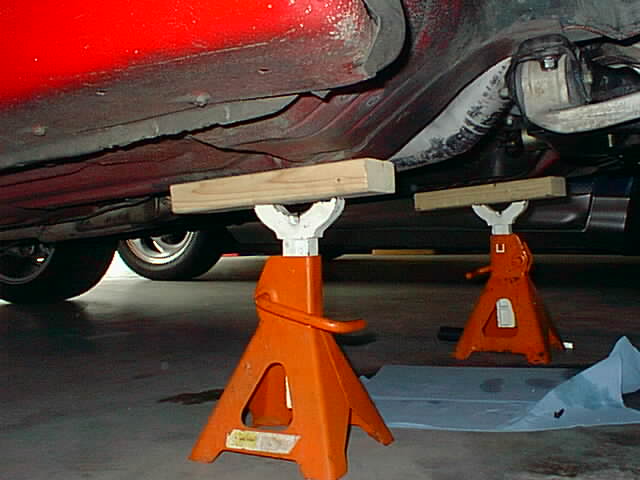
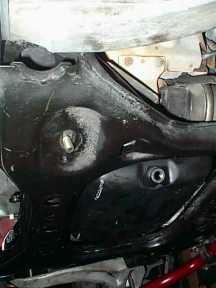
This is a picture from the passenger side of the car showing
where the he RHS Motor Mount attaches to the sub frame.
I have already removed the nut from the bottom of the mount
and drained the oil.
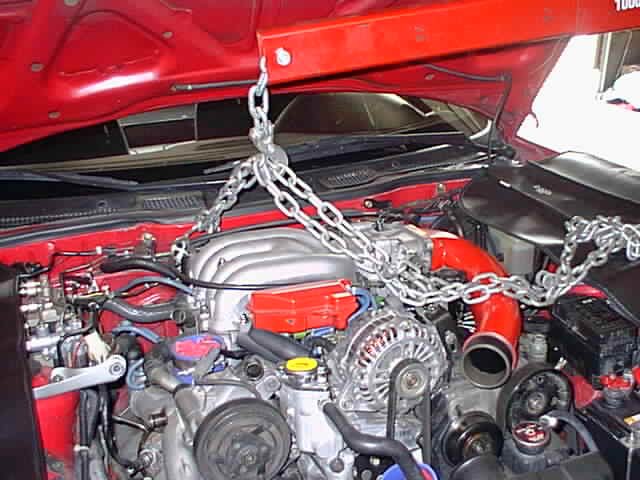
The motor mounts in this car are filled with oil and should be
closely inspected for damage. Now would be a good time to
replace the motor mounts if they are leaking.
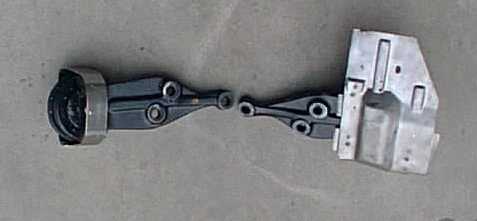
If you can't get it through the opening you will have to unbolt the power steering and drop the sub frame. The power steering is only four bolts and then just push it out of the way.
The sub frame is four nuts and two bolts. These were on really tight on my car. It took a 4' steel pipe to break them loose. I broke 1 extension, 1 adapter, and 2 sockets, and 1 socket wrench breaking the torque loose. I must point out that all of the above broken tools were Craftsmen.
Once the PS and sub frame are out of the way the pan should
come right out.
Make sure the pan is stright. A little persuasion with a soft
mallett may be required. If you are not sure it will seal you
may as well replace it.
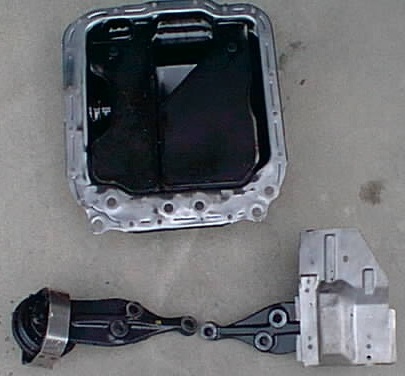
If it still leaks you may have a really warped pan or you may have not gotten Ultra-Black in all the places you should have.
Go get the car aligned as soon as possible. (If you had to drop the sub frame.)
________________
Date: Fri, 17 Sep 1999 16:40:21 -0500
From: "Westbrook, Chuck E." (CWestbrook@tmh.tmc.edu)
There are several theories about the newest and best way to seal a pan with and without using a gasket. The problem is that the oil pan gasket is stiff and hard. Therefore it can't conform to any irregularities nor will it help to retighten the bolts. When using any sealant with a gasket, both sides have to be covered. That means you have twice the chance of having a leak than if you use no gasket at all because you have twice the surface area. So I decided to not use a gasket.
In short; I cleaned the pan and engine block sealing surfaces several times with lacquer thinner, placed a heavy bead of Permatex ULTRA BLUE on the pan sealing surface and around the bolt holes, and bolted it up without a gasket. To help the 10mm bolts more evenly spread their holding force and to also help prevent warping the pan edge, small flat washers were also used. Results, no oil leaks. Following is my ordeal in doing this project by myself, and with the help of Rick Sheveland's garage and engine lift.
There were several postings, and some RX7 sites detail how to due this project without dropping the subframe. That method was tried with no results on my March 1992 build R1. Still had to drop the subframe. If I had approached it this way from the beginning, it would have been quicker and easier; contrary to what some others have said. It all depends on how hard it is to remove the 4 nuts and 2 bolts that secure the subframe. Maybe you should try breaking them loose ASAP before going to far into the process if you don't think you are up to the task.
I used a 1/2" drive torque wrench and did not break any extensions or sockets. Of course afterwards the suspension has to be re-aligned. The 1993 Mazda RX7 Workshop Manual page D-10 was used as a guide with some improvements.
You did replace the pan drain plug, didn't you?
________________
Date: Sun, 01 Feb 1998 16:03:14 -0800
From: NetBlazer (netb@WhyWeb.com)
> How hard was it to remove the sub-frame? > Remove the strut tower bar 2x14mm > Jack up the front of the car. > Put jack stands anyplace but on the subframe. I used some 10" long 2x4's > on top of the stands to spread out the load out behind the fire wall. > Pull both the front wheels - 10x21mm nuts > Pull plastic under tray - about 12x10mm bolts > Pull sway bar - 4x12mm bolts 2x14mm nuts > Unbolt power steering rack - 4x14mm bolts > Attach a hoist to the motor and take up the slack - hoist, chain, > u-bolts > Disconnect the motor mounts from the sub frame - 2x14mm > Drop the sub frame down - 4x17mm bolts and 2x17mm nuts. > This does not remove the sub-frame, it only loosens it enough to pull it > out of the way while you get the pan in and out. In order to remove it > completely you would need to disconnect the front lower ball joints, and > the lower strut nut. I think.
This is false. I have completly removed an oil pan, replaced the gasket, and re-installed it with no leaks to date (my dads car) and never loosened the subframe in any way.
Ignore the shop manual on this as it is designed to burn as much time as possible. I firmly believe I could pull the whole engine, change the pan, and reinstall the engine for the amount of time they have into doing the oil pan their way.
Anyway, simply remove the strut tower brace, unhook the oil lines, unbolt the motor mounts at the subframe (two nuts) and lift the engine up until the tranny just touches the top of the tranny tunnel. Unbolt the motor mounts from the engine, now using a 1/4" drive universal, a 1/4" drive 10mm socket and a 1/4" drive extension and socket wrench unbolt all the 10mm bolts which go around the pan.
Use some sort of mortar spatuala or paint scraper, and carefully run it around between the pan and engine to seperate it without causing it to warp (most pan warpage is from people trying to pry it off). Lower the pan, and work it around until you can get the baffle clear of the oil pickup. Given the correct angle, the pan will slide out from under there.
This procedure is also valid for changing the front cover gasket, with a few additional steps.
_______________
From: Westbrook, Chuck E. (CWestbrook@tmh.tmc.edu)
Date: Wed Jun 28 2000 - 09:03:16 EDT
Rick Sheveland and I do not use gaskets on the engines that we work on. A gasket gives twice the area that can leak. We extremely clean the pan and block mating areas and insure that the pan is not warped or bent where it contacts the block. Then we use ULTA BLUE Silicone sealant to seal it. Place about a 1/8" bead down the middle of the side and front pan surfaces and around each bolt hole. For the rear you go around each bolt hole and where it mates to the block. Let it set for 24 hours before filling up with oil. We haven't had any leaks since using this method.
_______________
Date: Thu, 20 Jul 2000 13:00:26 EDT
From: "Firas Arabo" (firas_arabo@hotmail.com)
Subject: Re: (rx7) (3) oil drain plug spec?
>I need to replace my oil pan drain plug...anyone know the size >and thread specs?
14x1.50
_______________
Date: Mon, 11 Oct 1999 15:13:45 PDT
From: "Firas Arabo" (firas_arabo@hotmail.com)
I just did the motor mounts over the weekend, and this is what was involved. I have a 9/93 build date, with 89362 miles.
Parts:
The new driver's side mount was definitely different in design. The rubber mount looked like it had been turned upside down when compared to the old mount. Certain areas were thickened on the rubber mount. The metal bracket that surrounds the mount was almost twice as thick as the old one. The front-facing side of this metal bracket was wider by about 1.5 times. And the mount arm was shaped differently were it slides under the rubber mount.
The right side looked identical to the old one. It didn't come with the heat shield, so I had to remove the 3 10mm that held it to the old mount.
3/8" wratchet, short 17mm socket, 14mm and 10mm. (can be short), ultra black silicone.
Labor:
Once I got the the mounts on, I could clearly see that the stud for the driver's side mount was not going to clear the sub-frame opening. It was too far over to the driver's side and forward, by about the thickness of the stud itself. From this point on, I spent about 1.5 hours scratching my head, trying to force the assembly over to the passenger's side, but no luck.
Finally, I lifted the motor back up, removed the driver's side mount,
then fit its stud into the sub-frame, slid some 2x4's under the passenger
side mount, then slowly lowered the motor assembly in an attempt to get the
motor to rotate down towards the driver's side so that the bolts had a
straight path into the mount arm. Well, it worked. I was able to get the
bolts on with the stud already in place on the sub-frame. The bad part was
that after rotating the assembly by a small amount, it was a small enough
difference to keep me from fitting my torque wrench onto the bolts for the
driver's side. I torqued the passenger side bolts to 62 ft/lbs, book
specifies 55-68 ft/lbs, and at no time did it feel like the threads would
break loose. I'll have to keep a close eye on the driver's side mount bolts
in the future.
The result, cold starts feel smoother, probably because my driver's side mount had completely separated off the arm ;-) The throttle seems to be a bit smoother too as you feather the accelerator. I also gained about 1/8" clearance in between my downpipe (N-Tech) and the sidewall.
